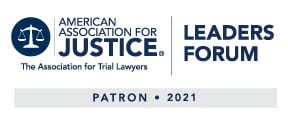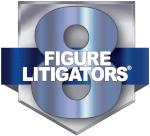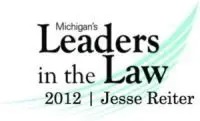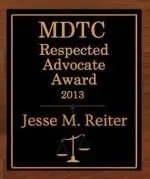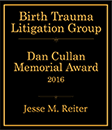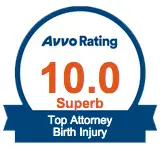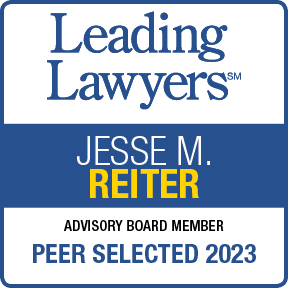Hypoxic-Ischemic Encephalopathy (HIE) and Infant Seizures
Birth Asphyxia, HIE, and Seizures
Hypoxic-ischemic encephalopathy, or birth asphyxia, is a type of neonatal brain injury that is caused by a lack of oxygen at or around the time of birth. This oxygen deprivation can be due to decreased oxygen in the baby’s blood (hypoxemia/hypoxia) and/or decreased blood flow (ischemia) to the brain.
HIE is the most common cause of neonatal seizures, with approximately 80 percent of seizure cases attributed to HIE. In fact, seizures may be the first, and in some cases only, clinical sign of a brain disorder in a newborn.
Seizures frequently develop in babies who experienced birth asphyxia during the first 24 hours of life. The occurrence of seizures can worsen a brain injury, and it therefore is crucial for physicians to implement appropriate and timely treatment of seizure activity.
What is a Seizure?
Our actions are controlled by neural impulses, which are signals that travel from nerve cells to other nerves, muscles, organs, or tissues. Seizures occur when there is an excessive synchronous electrical discharge – uncontrolled electrical activity in the brain – that produces conditions such as convulsions, brain disturbances and altered consciousness. Seizures can damage the brain. The longer seizures last and the more frequently the seizures occur, the worse the outcome for the baby.
Tell us your story.
Call ABC Law Centers today to secure your child’s care and reclaim their future.
What Do Seizures Look Like in a Baby?
Seizures in a newborn are often short and subtle; it can be difficult to determine whether a baby actually is having a seizure. Signs and symptoms of an infant seizure include the following:
- Apnea (periods of breathing cessation)
- Repetitive facial movements, including sucking, chewing, or eye movements
- Unusual bicycling or pedaling movements
- Staring
There are a few different types of infant seizures:
- Clonic seizures, which are rhythmic jerking movements that may involve the muscles of the face, tongue, arms, legs, or other body regions
- Myoclonic seizures, which are quick, single jerks involving one arm or leg, or the entire body
- Tonic seizures, which involve stiffening or tightening of muscle groups; the head or eyes may turn to one side, or the baby may bend or stretch one or more arms or legs
Why and How Does Hypoxic-Ischemic Encephalopathy Cause Seizures?
When hypoxia and ischemia occur, there is a cascade of events that cause a decrease in energy production in the brain. This can lead to an increase in an excitatory neurotransmitter (brain messenger) called glutamate, which causes excessive activity in the cortex (tissue that covers the largest, most highly-developed part of the brain). In conjunction with an increase in glutamate, there is a deficit of an inhibitory neurotransmitter, as well as changes in cellular membranes that affect energy production. In short, hypoxia and ischemia can cause a decrease in energy production in the brain, which can cause excessive excitation of brain impulses and seizures.
Other Causes of Seizures
Other causes of and risk factors for neonatal seizures (many of these conditions also cause hypoxic-ischemic encephalopathy) include the following:
- Umbilical cord compression
- Problems with the placenta or uterus, such as a ruptured uterus or placenta previa
- Trauma to the baby’s brain during delivery
- Intracranial hemorrhage
- Stroke
- Infections such as meningitis, GBS, encephalitis, cytomegalovirus and HSV (herpes)
- Metabolic problems, such as hypoglycemia, hypocalcemia, and hypomagnesemia
Diagnosing and Treating Seizures
Seizure activity in an infant must be diagnosed and treated immediately because seizures can cause and worsen brain damage. Furthermore, seizures can adversely alter brain function in ways other than by killing cells; rewiring of brain circuitry and the birth of new brain cells may lead to even more seizures. Even isolated, brief seizures can damage the brain. Listed below are factors that influence how much brain damage a seizure will cause:
- Seizure severity and how much electrographic seizure activity is present on EEG
- The degree of brain involvement
- The duration of the seizure
- The frequency of seizure activity
- The cause of the seizure (most important factor)
The longer the seizure activity is left undiagnosed and untreated, the greater the potential for permanent damage to the baby. Brain damage caused by seizures is associated with declines in cognitive function, and newborn babies that experience seizures often are afflicted with cerebral palsy and cognitive impairments.
The presence of a low Apgar score (< 7 at five minutes), acidosis, and the baby needing intubation and mechanical ventilation (having a tube put in the upper airway and being placed on a breathing machine) should alert the physician that seizure activity is likely to have occurred or will occur.
If a baby has risk factors for seizure activity or shows signs of seizures, they should be monitored very closely. An EEG should be performed to determine if the baby is having seizures. In addition, an MRI or CT scan may need to be done to determine the cause of the seizures. It is crucial that physicians promptly determine and treat the underlying cause(s) of the seizures so that brain damage is minimized and future seizures are decreased or prevented. In addition to treating the underlying cause of the seizure, the seizure itself typically requires emergent therapy since it can negatively impact the baby’s homeostasis (stability). If indicated, antiepileptic drugs should be given to prevent seizures.
Causes of and Risk Factors for Hypoxic- Ischemic Encephalopathy
HIE is a very serious condition that can cause permanent damage. A baby with HIE may have seizure activity as a result of HIE. However, the baby may have seizures due to a reason other than HIE. Or, in other circumstances, the newborn may be experiencing seizures due to multiple conditions, such as an infection and HIE. HIE and seizure activity can both cause permanent brain damage, and when they occur together, the chances of severe injury are greatly increased.
As the most common cause of neonatal seizures, every effort must be made to prevent HIE and to minimize its severity. Common causes of and risk factors for HIE include the following:
- Preeclampsia
- Post-term pregnancy
- Intrauterine growth restriction (IUGR)
- Premature Rupture of Membranes (PROM)
- Chorioamnionitis and villitis
- Meconium aspiration
- Macrosomia
- Placental abruption
- Uterine Rupture
- Tight nuchal cord
- Umbilical cord prolapse
- Malposition of the baby, such as breech presentation
- Delayed emergency C-section
- Severe maternal hypotension (very low blood pressure)
- Maternal hypertension (high blood pressure)
- Fetomaternal hemorrhage
- Intracranial and intraventricular hemorrhage
- Traumatic delivery, which can occur when forceps or vacuum extractors are used, and when shoulder dystocia occurs (shoulder is trapped behind mother’s pelvis)
- Excessively strong and frequent uterine contractions, called hyperstimulation, which can result from improper use of Pitocin or Cytotec
- Gestational diabetes, especially when accompanied by severe IUGR
- Stroke around the time of birth (perinatal stroke). The majority of babies with ischemic perinatal stroke develop seizures.
Our team can help.
Secure your child’s future. Call the trusted birth injury attorneys at ABC Law Centers now.
Diagnosing and Treating Hypoxic-Ischemic Encephalopathy (HIE)
A baby with HIE may have an abnormal state of consciousness (e.g., be hyperalert, irritable, lethargic, or far from alert), breathing or feeding difficulties, poor tone, or seizure activity. Neuroimaging is important in the evaluation of HIE, and can provide information about the type and timing and extent of brain injury.
Babies with severe HIE may exhibit profound metabolic acidosis on an umbilical cord arterial blood sample (the baby’s blood is acidic, signifying a problem with ventilation and/or oxygenation), and early onset of encephalopathy (central nervous system dysfunction). When these factors are present, there is a strong likelihood of the child developing cerebral palsy.
The management of mild to severe HIE should take place in a neonatal intensive care unit, and should include the following:
- Maintenance of adequate ventilation (avoidance of too much or too little oxygen or carbon dioxide)
- Maintenance of sufficient brain and organ blood flow (avoidance of low or high blood pressure; avoidance of abnormally high cell counts, such as high red blood cell counts)
- Maintenance of normal metabolic status (normal blood sugar levels, normal nutrition, normal pH (acid/base balance in blood))
- Control of seizures
Hypothermia therapy is the only effective method currently available for treating hypoxic-ischemic encephalopathy .The treatment should be initiated within 6 hours after birth (or the oxygen-depriving incident), and may last up to 3 days. Selective head cooling and whole body cooling reduce the baby’s brain temperature to just a few degrees below normal. This slows the metabolic rate and can help prevent much of the cellular injury and death that occurs as a result of hypoxia and ischemia. Although studies in this area are ongoing, the current state of research shows that hypothermic therapy increases a severely injured full-term infant’s chance of surviving without detectable brain damage at 18 months by about 50 percent.
Birth Asphyxia, Hypoxic-Ischemic Encephalopathy (HIE), Seizures, and Medical Malpractice
Standards of care must be followed at all times to avoid complications that give rise to hypoxic- ischemic insults. A mother and baby must be closely monitored during labor and delivery, and proper prenatal testing must be performed in order to avoid conditions that can lead to HIE and seizures. Failure to properly monitor a mother and baby and to follow standards of care is negligence. If a physician fails to recognize signs that a baby is having or is likely to have seizure activity, and seizures and the underlying causes go untreated, it is negligence. If the negligence results in injury to the baby, it is medical malpractice.


Legal Help for HIE, Seizures, and Other Birth Injuries
If your child was diagnosed with a birth injury, such as hypoxic-ischemic encephalopathy (HIE), a seizure disorder, or cerebral palsy, the award-winning birth injury lawyers at ABC Law Centers can help. We have helped children throughout the country obtain compensation for lifelong treatment, therapy and a secure future, and we give personal attention to each child and family we represent. Our nationally-recognized birth injury firm has numerous multi-million dollar verdicts and settlements that attest to our success, and no fees are ever paid to our firm until we win your case.
- Free Case Review
- Available 24/7
- No Fee Unless We Win
Featured Videos
Posterior Position
Hypoxic-Ischemic Encephalopathy (HIE)

Featured Testimonial
What Our
Clients Say…
After the traumatic birth of my son, I was left confused, afraid, and seeking answers. We needed someone we could trust and depend on. ABC Law Centers was just that.
- Michael
Helpful resources
Disclaimer: Please know that our website is owned by a medical malpractice law firm that focuses exclusively on birth injury cases. We try to provide useful medical information to our readers, but we cannot provide treatments or medical advice. If you might be having a medical emergency, please call 911 (or your country’s emergency number) and seek immediate medical attention.
The information presented above is intended only to be a general educational resource. It is not intended to be (and should not be interpreted as) medical advice.









